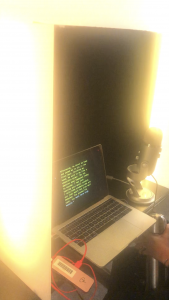Na Chen
An interactive installation that sheds light on the heavily censored #metoo movement in China
https://nachen.info/2019/12/10/confession-booth/
Description
This is an installation that sheds light on the heavily censored #metoo movement in China last year. Participants can interact with it either inside or outside a confession booth. The person inside the booth — or the “speaker” — will read a paragraph out loud, which will be a first person account from a real sexual assault victim. As they’re reciting the passage, a p5 sketch will use speech recognition to detect their voice. If the words are not clearly uttered, a high pitch sound will be triggered to interfere with the participants. Outside the booth, other participants — “listeners” in this case — will hear the message delivered by the speaker and see the booth blinking every time the speaker gets the word right. The noise in this case symbolizes the censorship apparatus in China and the light is the symbol of the user's endeavor. In order to turn off the speaker, the participants need to speak louder and clearer. The purpose is to create an uncomfortable yet empowering experience and put participants into the shoes of sexual assault victims.
Classes
Introduction to Computational Media, Introduction to Physical Computing, The Uses of Discomfort


